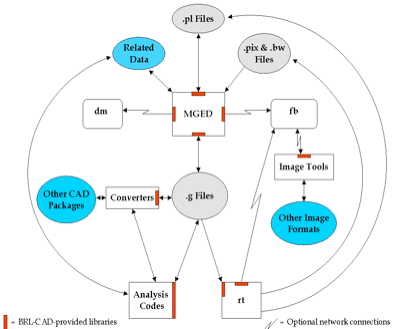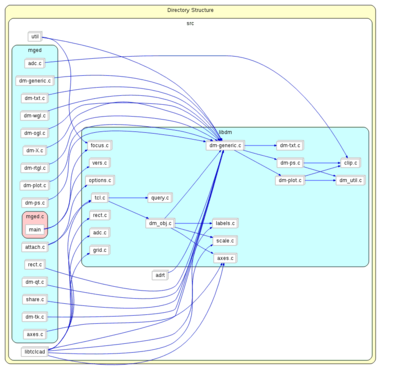Difference between revisions of "Geometry Viewer Application for BRL-CAD"
Asadmorgoth (talk | contribs) (Linked librt with standalone application. All librt functions are now available in our standalone application.) |
Asadmorgoth (talk | contribs) (Source code analysis of libdm and it's interaction with mged.) |
||
| Line 87: | Line 87: | ||
* Interface with libdm | * Interface with libdm | ||
| + | Interfacing with librt was aided by the hello_world example but interfacing librt was a bit more tricky due to lack of resources. To find out the function calls, dependencies and call graph of "mged->libdm" I used profiling tools and printfs. Currently I have understood the basic architecture of the interaction: | ||
| + | |||
| + | [[Image:ClusterCallby-libdm.png|396px|center|libdm interactions with mged]] | ||
| + | |||
| + | |||
| + | Now I am in the process of figuring out which calls are required by my application source. | ||
; 4. Create application interface with model file: | ; 4. Create application interface with model file: | ||
* Create input interface to parse “.g” file | * Create input interface to parse “.g” file | ||
Revision as of 12:38, 28 June 2016
European Summer of Code 2016
Mentor: Christopher Sean Morrison
Student: Asad
This document lists down the design for the project. This includes the major milestones and deadlines. Prettier Version
Contents
Outline
The idea is to build a geometry viewer application that generates a standalone double-clickable file that views a given model. The approach is to concatenate the contents of a given “.g” file with the function calls from librt, libdm that parse and display a “.g” file, in a standard brlcad setup.
Our motivation is to introduce portability and ability to share results of brlcad via email with users who don’t have brlcad setup in their environments. First we will develop a standalone application but later this can be integrated into mged or any other tool as a brlcad feature.
Status (22.03.2016)
Our source code takes a .g file as input and stores it into a buffer. It can also pass this file to librt and populate the db_i structure. Currently we are trying to interface it with libdm.
Task Breakdown
The brlcad suite has many tools and libraries that interact with each other to render and view models. The general architecture is given below:
The most important part for us out of this architecture is the geometry rendering libraries, to be more specific librt & libdm.
• Librt, the library that contains all of the geometry support. It parses the “.g” file and its function calls can be used to extract contents of “g” file. We will use this to parse our model file for Libdm. The relevant function call is “db_open”. There is also possibility to use a higher level library “libged” (ged_open)
• Libdm is BRL-CAD's primary graphics display manager (dm) library. It is used to display geometry in GUI. This will be utilized by our source to visualize model files.
This resulting draw result will then be bundled into an “.exe” (windows) and later into packages for Mac & Linux.
Task list
- 1. Evaluate technology to be used
Develop initial project design draft[DONE]- Setup development environment
- Installing BRLCAD: (Install Instructions)
- System Specs: CentOS 7, Dual Core, 4G RAM, 40 G Storage
<source lang="bash">
- Fetch the STABLE version of BRLCAD (7.24.4):
svn checkout http://svn.code.sf.net/p/brlcad/code/brlcad/branches/STABLE/ brlcad-stable
cd brlcad-stable
mkdir brlcad-build
cd brlcad-build
cmake ../ -DBRLCAD_BUNDLED_LIBS=ON -DCMAKE_BUILD_TYPE=Release -BRLCAD_ENABLE_STRICT=OFF
- Without enable strict we get an error: "array subscript is above array bounds" during make
make -j6
make install
vim ~/.bash_profile
- Add "/usr/brlcad/rel-7.24.4/bin" to PATH.
vim brlcad-7.24.4.conf
- Add "/usr/brlcad/rel-7.24.4/lib"
ldconfig
</source>
- Evaluate programming language choice (C decided, for GUI may use some Python)
- 2. Evaluate and look into current viewer applications
- Mged / archer
- Isst, it doesn’t use libdm.
- Geometry viewer [1]
- 3. Create application interface to brlcad libraries [2]
- Interface with librt
Librt is used to open brlcad geometry files and edit them. It reads a .g file by calling the function db_open and populates a db_i structure . To view the geometry files we need Libdm which takes this db_i structure as input to do so.
This commit takes a .g file and calls the db_open function from within the viewer application. Right now it just prints out a single value from the populated structure.
An example is already available that shows the usage of db_open. We are utilizing the skeleton of this example to populate the struct db_i.
- Interface with libdm
Interfacing with librt was aided by the hello_world example but interfacing librt was a bit more tricky due to lack of resources. To find out the function calls, dependencies and call graph of "mged->libdm" I used profiling tools and printfs. Currently I have understood the basic architecture of the interaction:
Now I am in the process of figuring out which calls are required by my application source.
- 4. Create application interface with model file
- Create input interface to parse “.g” file
We need to read the binary ".g" file and concatenate it with our program. The first step is to identify the .g files from their file header. Using the hexdump command it is confirmed that all " .g" files have first 40 bytes common. <source lang="bash"> hexdump -C build/share/db/wave.g | head 00000000 76 01 00 00 00 00 01 35 76 02 00 00 00 00 0a 00 |v......5v.......| 00000010 00 00 00 00 00 00 00 00 00 00 00 00 00 00 00 00 |................|
00000050 00 00 00 00 00 00 00 35 76 02 00 00 00 00 02 00 |.......5v.......| 00000060 00 00 00 00 00 00 00 35 76 20 00 20 01 04 1a 06 |.......5v . ....|
00000070 62 61 73 65 31 00 c0 40 82 c0 00 00 00 00 00 c0 |base1..@........|
</source>
The commit, simply reads a file into a buffer and prints out its contents. Our interest is in the header bits of the file i.e., the bits that start with 7601...., these will help us identify the start of a ".g" file later.
- Create output interface to parse output from libdm.
- 5. Develop front end
- Develop Single window view
- Develop File Input
- 6. Write Functional testing test cases.
Project Workflow
- This design document will be updated regularly to include the status of tasks as well as any changes in project scope and/or approach.
- The source will be uploaded on: [3]
- There will also be occasional weekly status meetings on irc #brlcad (Fridays 16:00 GMT+2)

